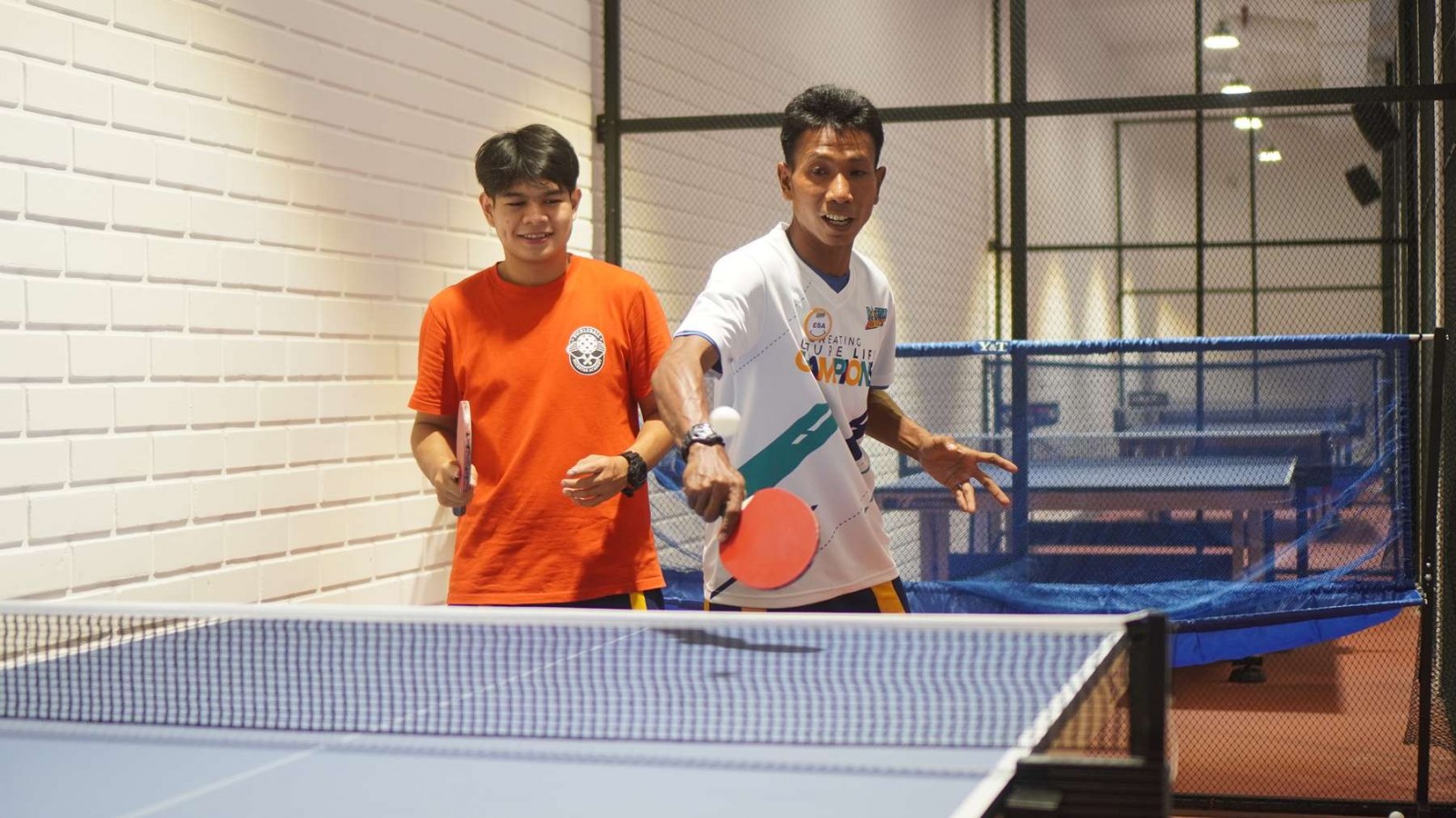How to Serve in Ping Pong: Proper Position and Techniques

Serving is one of the most crucial aspects of ping pong, as it sets the stage for the rally and can put your opponent at a significant disadvantage if done correctly. Mastering the ping pong serve involves understanding the proper position, techniques, and various types of serves to keep your opponent guessing.
This foundational technique not only initiates play but can also give you a strategic advantage over your opponent. This article will guide you through the essentials of a ping pong serve, including proper positioning, spin techniques, basic and advanced serves. Let’s dive in!
How to Serve in Ping Pong
Serving in ping pong is more than just a way to start a point, it’s an opportunity to set the stage for a successful rally. With the right technique, you can gain a significant advantage and make your games more exciting. Let’s explore how you can perfect your ping pong serve:
A. Getting into the Proper Position
To execute an effective ping pong serve, start by holding the ball flat in the palm of your hand. Ensure that the ball remains above the level of the table and behind your serve line to comply with the rules.
Your racket hand should stay below the level of the table to keep it hidden from your opponent. Toss the ball at least 6.3 inches (16 cm) into the air, and strike it as it begins to fall.
Ensure the ball bounces on your side of the table before crossing the net. If playing singles, the ball can land anywhere on the opponent's side, but in ping pong doubles, it must hit the opposite diagonal court.
Finally, move your free arm away from the ball immediately after serving to maintain balance and prevent interference.
B. Learning Spins
Mastering spins can significantly enhance your serves. For a topspin serve, use a closed racket and graze the ball from the top to create upward rotation.
Conversely, for a backspin serve, employ an open racket and brush the ball from the bottom, resulting in downward rotation. To achieve sidespin, graze the ball on its sides while incorporating fast wrist movements to amplify the spin.
Mastery of these techniques will make your serves more deceptive and challenging for your opponents.
C. Doing Basic Serves
Begin with basic serves to build a solid foundation. Angle your body about 45° away from the table, keeping your knees bent and legs shoulder-width apart for stability. Bend slightly forward to maintain balance.
Hold your racket with your elbow bent at a 90° angle, ready to move. For a forehand backspin serve, move the bat down and forward. To perform a forehand topspin serve, hit the ball up and forward.
For backhand serves, turn your arm across your body to execute the serve effectively. These basic serves will help you develop control and consistency.
D. Doing Advanced Serves
Advanced serves add complexity to your game. For a short backspin serve, use a short stroke to keep the ball low and short. Adding sidespin to a backhand serve can make it difficult for your opponent to return.
A high toss can generate more spin. The forehand pendulum serve involves striking from left to right, while the reverse pendulum serve strikes from right to left. The tomahawk serve, executed by striking right to left with the racket tip up, creates a unique angle.
Practice varying the length, spin, and placement of your serves to become more unpredictable and challenging.
Types of Ping Pong Serves
In ping pong, mastering a variety of serves is crucial for maintaining an edge over your opponent. Each type of serve has its own characteristics and can be used strategically to gain an advantage. Here’s a look at the different types of ping pong serves and their applications:
1. Chop Serve
The chop serve involves using a slicing motion to impart backspin on the ball. This technique is executed with an open racket face and a downward motion, making the ball dip quickly and stay low after bouncing.
The chop serve is effective for disrupting your opponent’s rhythm and forcing them to adjust to the low bounce.
2. Pendulum Serve
The pendulum serve is a popular technique where the racket swings in a pendulum-like motion from left to right (or vice versa). This motion generates significant sidespin and is often combined with topspin or backspin.
The pendulum serve can create a sharp curve, making it challenging for your opponent to anticipate and return.
3. Reverse Pendulum Serve
The reverse pendulum serve is similar to the traditional pendulum serve but with a reverse motion from right to left. This serve also generates sidespin but can be more deceptive due to its unconventional direction.
It’s a versatile serve that can be combined with other spins to further confuse your opponent.
4. Corkscrew Serve
The corkscrew serve uses a spiraling motion to impart a unique spin on the ball. By striking the ball with a rotating motion, the corkscrew serve generates a combination of sidespin and topspin or backspin.
This serve causes the ball to curve unpredictably, making it difficult for your opponent to read and react.
5. Shovel Serve
The shovel serve involves striking the ball with a low, sweeping motion, similar to the action of a shovel. This technique generates backspin and keeps the ball low and short.
The shovel serve is effective for breaking your opponent’s rhythm and making it challenging for them to execute an aggressive return.
6. Tomahawk Serve
The tomahawk serve is executed with a distinctive overhead motion where the racket strikes the ball from right to left with the tip of the racket facing upwards.
This serve generates a combination of topspin and sidespin, causing the ball to curve sharply.
The tomahawk serve is highly effective for creating unpredictable angles and challenging your opponent’s positioning.
7. Reverse Tomahawk Serve
The reverse tomahawk serve is the opposite of the traditional tomahawk serve. In this variation, the racket strikes the ball from left to right with the tip facing up.
This serve imparts a unique spin and trajectory, often combining topspin and sidespin, making it difficult for your opponent to anticipate and counter.
8. Backhand Tomahawk Serve
The backhand tomahawk serve is a variation of the tomahawk serve executed with a backhand grip. The racket swings from left to right, creating a combination of sidespin and topspin.
This serve is useful for surprising your opponent with an unexpected angle and spin, especially when they are accustomed to forehand serves.
9. Ghost Serve
The ghost serve is designed to be deceptive, often involving minimal spin or a combination of subtle spins. It is quite similar with chop serve.
The aim is to make the ball’s trajectory and bounce difficult for your opponent to read, creating the illusion of a ghostly movement. This serve is effective for catching opponents off guard and breaking their rhythm.
10. Float Serve
The float serve, also known as a no-spin serve, is executed with minimal or no spin. The ball travels with a relatively straight trajectory and unpredictable bounce due to the lack of spin.
This serve can be particularly effective against opponents who rely heavily on spin, as it disrupts their timing and approach.
Start Serving Up Success Now!
A well-executed ping pong serve can be a powerful tool in your table tennis arsenal. Remember, the key to a successful serve is practice and adaptability. Keep honing your skills, and you'll find yourself serving up success on the table!
Elevate your ping pong skills with a top-notch training program at Rockstar Academy! Our comprehensive Ping Pong Program is designed to enhance your game, whether you're a beginner or looking to sharpen your competitive edge.
At Rockstar Academy, part of the prestigious Sports & Performing Arts Academy, you'll receive expert coaching and access to state-of-the-art facilities, preparing you for prestigious events like the RockOlympics.
To help you get started, we are excited to offer a Ping Pong free trial, allowing you to experience the full range of our training and see firsthand how we can help you achieve your goals. Don’t miss this opportunity to get a taste of excellence, sign up for your free trial today!
FAQ
How to improve ping pong serve?
Focus on perfecting your grip, practice different spins, and experiment with varying speeds and placements. Consistent practice and analyzing your serves will also help refine your technique.
Where should the ball bounce for a legal serve?
The ball must bounce on your side first before crossing the net and landing on the opponent’s side.



